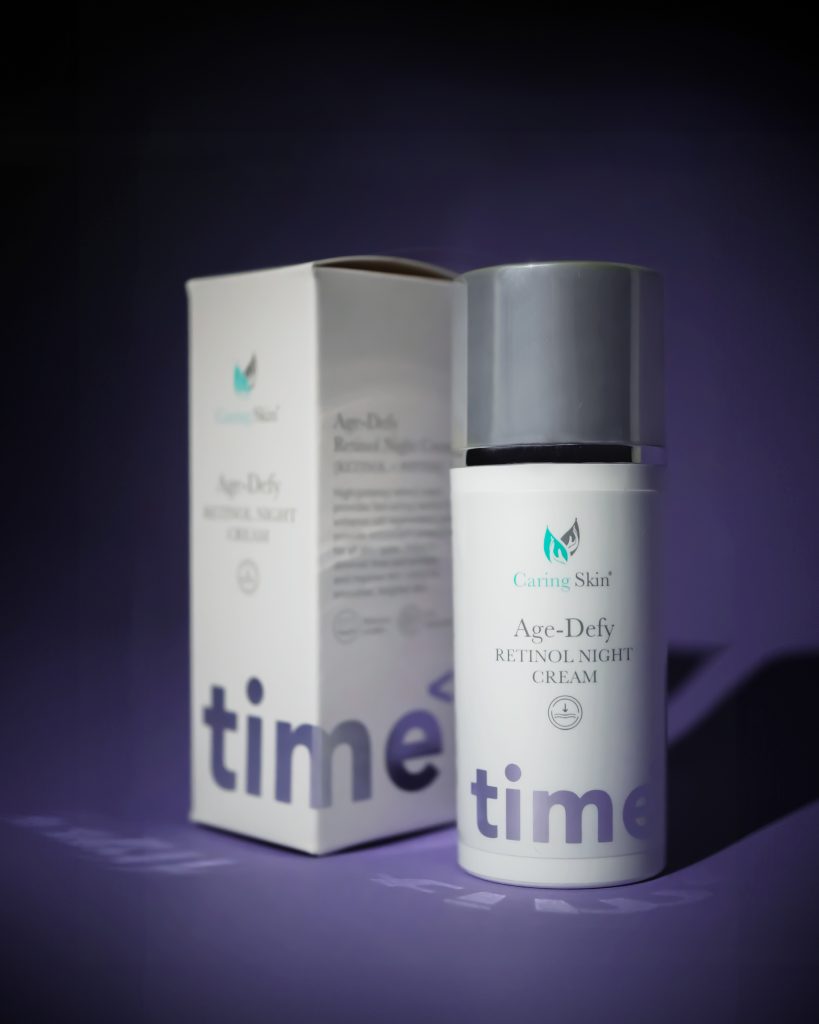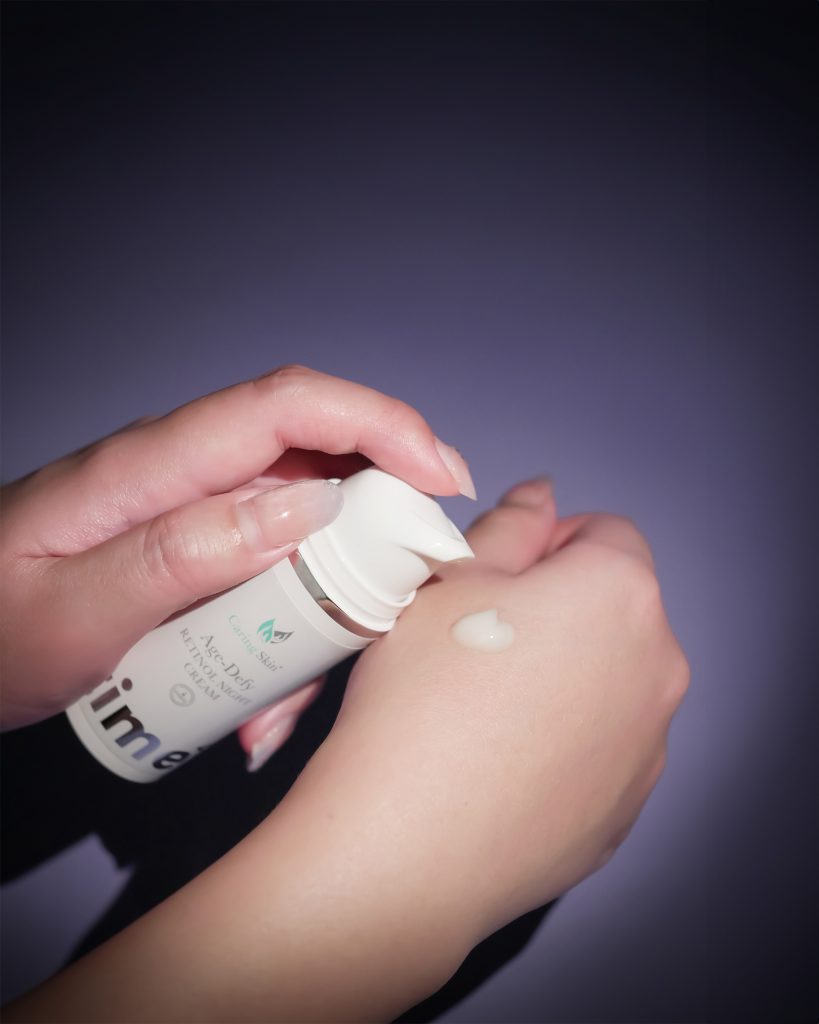When temperatures drop, our skin often becomes drier, tighter, and more reactive. For many, this raises an important question: Can you still use Retinol during colder months if you have sensitive skin? The good news is yes! You absolutely can! With the right techniques, products, and routines, Retinol can remain part of your skincare journey without causing irritation or flare-ups.
In this guide, we break down how Retinol works, how cold weather affects your skin, and how to safely introduce active ingredients, for dryness or sensitivity skin.
What Exactly Is Retinol?
Retinol is a type of Vitamin A derivative widely recognised as one of the most effective ingredients in modern skincare. It works by speeding up skin cell turnover, stimulating collagen production, and unclogging pores. When applied consistently, a Retinol serum or Retinol Night Cream can help improve fine lines, pigmentation, acne, uneven texture, and overall radiance. Because of its transformative results, Retinol is often recommended for those looking to achieve smoother, clearer, and more youthful-looking skin. However, Retinol can be strong, especially for those with sensitive skin which is why proper usage is essential, particularly during colder seasons when the skin barrier is more vulnerable.
Why Retinol Is a Winter-Friendly Ingredient (When Used Correctly)
Retinol, a derivative of Vitamin A, is well-loved for its powerful ability to increase cell turnover, fade pigmentation, smooth fine lines, improve acne, and enhance skin texture. Retinol serum and Retinol Night Cream are common favourites for those wanting brighter, healthier-looking skin.
But Retinol is also known to cause dryness, peeling, and sensitivity, especially during the adjustment phase. When cold weather is added to the mix, the risk of irritation increases because the skin barrier becomes naturally weaker in dry climates.
However, this doesn’t mean you should stop using Retinol in the cold. Instead, you simply need to adjust your routine to protect your skin barrier.
How Cold Weather Affects Sensitive Skin
If you already have sensitive skin, winter can make your skin feel:
Tight or dehydrated
Easily flushed or irritated
Rough in texture
More reactive to active ingredients
Low humidity and cold air strip natural oils more quickly, leaving your skin vulnerable. This is why many people find their usual skincare routine suddenly too harsh during the colder months.
For those using Retinol serum or creams, this means your skin may require extra cushioning, hydration, and a slower introduction of active ingredients.

How to Safely Use Retinol in Cold Weather
1. Start Slowly and Use the “Low and Slow” Retinol Method
If you’re new to Retinol or have sensitive skin, begin by applying it 2 to 3 times a week, then gradually increase the frequency as your skin adjusts. Cold weather months are not the time to rush.
A simple schedule might look like:
Week 1–2: Twice weekly
Week 3–4: Three times weekly
After 4 weeks: Every other night (only if your skin tolerates it)
This allows your skin barrier to adapt without being overwhelmed.
2. Try the “Retinol Sandwich” Technique
To buffer the skin from irritation, dermatologists recommend the sandwich method:
Apply a thin layer of moisturiser
Apply your Retinol serum or Retinol Night Cream
Seal with a second layer of moisturiser
This creates a protective cushion perfect for sensitive skin and cold, dry weather.
3. Choose a Gentler Retinol Formula
Not all Retinol products are equal. If your skin is sensitive, look for formulas labelled:
Encapsulated Retinol
Low-percentage Retinol
Sensitive-skin-friendly formulas
Retinol blended with ceramides, niacinamide, or hyaluronic acid
A Retinol Night Cream may be more comforting in winter because it usually contains hydrating ingredients to reduce dryness.
4. Hydrate Intensely Before and After Using Retinol
Moisture is your skin barrier’s best friend in cold weather. Look for moisturisers containing:
Hyaluronic acid
Ceramides
Squalane
Glycerin
Centella Asiatica
Panthenol
Hydrating serums before Retinol also help your skin tolerate active ingredients better.
5. Avoid Combining Too Many Actives on the Same Night
During colder months, sensitive skin becomes less resilient. To avoid irritation, avoid pairing Retinol with:
AHAs / BHAs
Benzoyl peroxide
Vitamin C (use in the morning instead)
Strong exfoliants
Stick to barrier-loving ingredients like ceramides, niacinamide, and peptides on your Retinol nights.
6. Don’t Skip Sunscreen, Even on Cloudy Days
Retinol increases photosensitivity regardless of weather. Even in winter, UV rays penetrate through clouds and windows, which can worsen irritation. Every morning, apply broad-spectrum SPF 30 or higher to prevent redness and hyperpigmentation.

Consider a Facial for Sensitive Skin to Support Your Retinol Journey
If your skin feels dry, itchy, or reactive during winter, booking a facial for sensitive skin can help stabilise your skin barrier before you continue using Retinol. These facials are designed to reduce inflammation, replenish hydration, and soothe irritation—creating an ideal foundation for active ingredients like Retinol to work effectively.
Professional treatments can also help you understand how to adjust your skincare routine throughout the cold season.
Signs You Should Slow Down Your Retinol Use
If you experience any of the following, reduce frequency or take a short break:
Persistent redness
Stinging or burning
Flaky patches around the nose or mouth
Increased sensitivity
Breakouts that worsen over time
Remember, Retinol should help your skin, not stress it.
Conclusion
Retinol remains one of the most effective ingredients for anti-aging and skin renewal, even during cold months. But sensitive skin requires gentler pacing, stronger hydration, and the right product choices such as a mild Retinol serum or nourishing Retinol Night Cream.
With a mindful approach, you can enjoy all the benefits of Retinol while keeping your skin healthy, hydrated, and comfortable all winter long.







